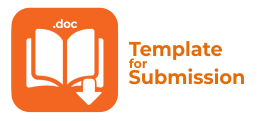Author Guidelines
ARTICLE TITLE (Times New Roman 12, bold, capital)
Article Author Name (Times New Roman 12, bold)
Abstract : Explaining the essence of the research conducted. The abstract contains a brief description of the problem and purpose of the research, the methods used, and the results of the research. The font used to compile the abstract is times new roman. The number of words in the abstract is a maximum of 250 words and is written in Bahasa Indonesia.
Keywords : Contains important words in research.
INTRODUCTION
(TIMES NEW ROMAN 12, SPACE AT LEAST 1,2)
In this section, the author presents symptoms or phenomena that are generally the background of the research problem, a little literature review, research problems/objectives, and without sub-headings. This section is the author's justification for the importance of conducting the research.
THEORY AND CONCEPT
In this section, the author describes and explains the theories and concepts that are used as the basis for the research and the literature that is relevant to the research problem (object) from various literature sources. The presentation in this section is an explanation and explanation of the theories and concepts that are used as the basis for the research. In presenting these theories and concepts, the author puts forward or describes various things, including expert views related to the meaning of the theory or concept that is the research framework and also expert views related to the elements, aspects or factors that build the theory or concept that is the research framework conducted.
RESEARCH METHODS
This section explains how the research was conducted. The research method is a scientific process or way to obtain data that will be used for research purposes. The main material in this section is adjusted to the type of research used.
RESEARCH RESULT
Contains the results and discussion of the research conducted. This section is the main part of the research article and is usually the longest part of an article. In this section the author describes the description of the phenomena, facts and data found in the field and their analysis. Tables and graphs can be used to clarify the presentation of research results and tables and graphs must be commented on or discussed (the description in the table must be visible above the table).
CONCLUSION
The conclusion of the research is the answer to the research problem. In this section, the author presents a summary of the description of the results and discussion referring to the research objectives / briefly describes the essence of the research findings (conclusions) based on the research results and discussion.
SUGGESTION
In this section, the author presents various suggestions or recommendations related to the problems and findings of the research results and discussions. Suggestions are compiled based on the research findings that have been discussed. Suggestions can refer to practical actions, the development of new theories, and/or further research so that the application of the studied science becomes better.
BIBLIOGRAPHY
(only load referenced libraries)
Example of writing a bibliography :
Effendi. 1993. Manajemen Sumber Daya Manusia. Open Dictionary Wikipedia, (Online), (http://wikpedia.edu/com, accessed on Februari 23, 2012)
Nawawi, H. Hadari. 2000, Manajemen Sumber Daya Manusia, Angkasa, Jakarta.




